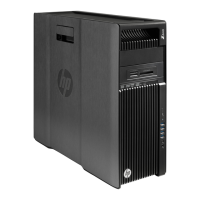1 3
Technical white paper | HP Z640 Workstation
AHCI (Advanced Host Controller Interface)
AHCI is a technical standard developed by Intel for the hardware mechanism that allows software to communicate with
SATA (Serial ATA) devices. It is enumerated as a PCI device and transfers data between system memory and SATA devices.
AHCI provides many benets over the legacy IDE (Integrated Drive Electronics) hard drive interface. Some of the benets
include:
• Elimination of master/slave handling.
• Native Command Queuing (NCQ) that allows a SATA device to internally optimize the order of command execution for
increased performance.
• TRIM command support for SSDs which keeps track of les that have been deleted but not erased on the drive. This
improves performance of the drive and helps extend the life of the SSD by preventing unnecessary writes.
RAID (Redundant Array of Independent Disks)
RAID provides a method of combining multiple disks into a single logical volume to increase performance or create data
redundancy.
RAID0 – Creates a single volume that has data striped across two or more drives on the same controller. The size of the
volume is based on the size of the smallest capacity drive times the number of drives in the RAID0 conguration. RAID0
is typically used to improve performance or create a larger volume from smaller drives. There is no data redundancy or
parity in a RAID0 conguration.
RAID1 – Creates a single volume that is a mirror image of identical data on two physical drives on the same controller.
The size of the mirror is limited by the smallest drive used in the RAID1 conguration. This conguration provides data
redundancy protection against a single drive failure, does not use parity, and does not improve performance. If a drive
fails, the drive can be replaced by a drive of the same capacity or larger capacity to rebuild the RAID array.
RAID5 – [sSATA controller only] Creates a single volume from three or more physical drives on the same controller. RAID5
uses striping with parity data in distributed blocks across all member disks. A RAID5 volume is tolerant of a single disk
failure. RAID5 has performance attributes similar to a RAID0 and reliability of RAID1, however parity calculations can
reduce the performance relative to a RAID0.
RAID10 – [sSATA controller only] Creates a mirror of pairs of drives, and then stripes the data on the mirrored pairs.
A RAID10 must contain two or more drive pairs, with a four drive minimum. A RAID10 is fault tolerant to one drive per
mirrored pair.

